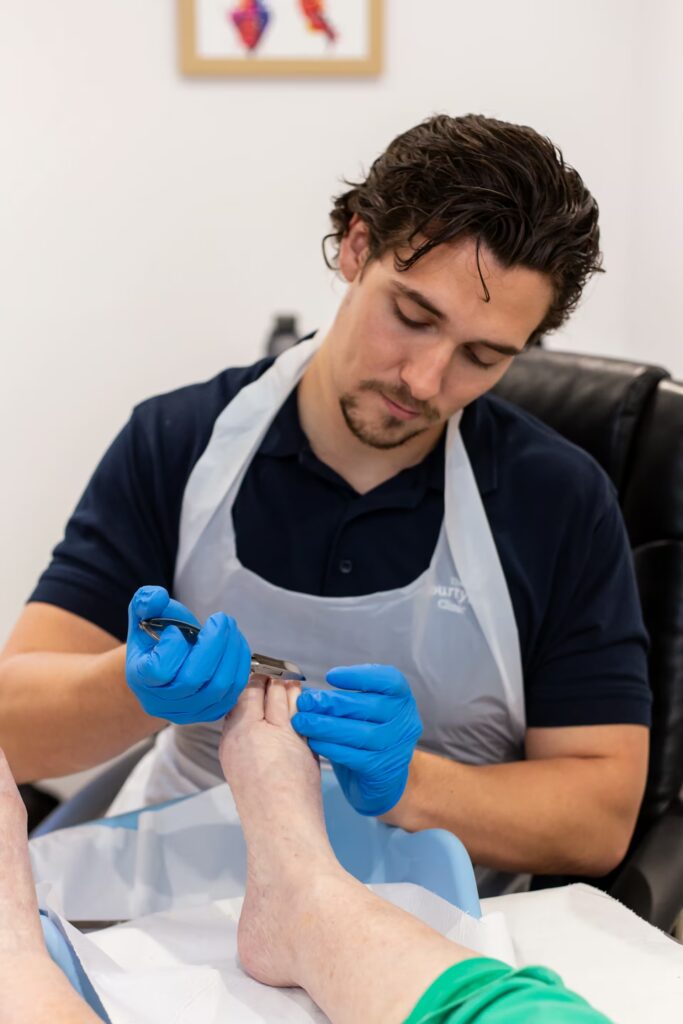About Ingrown Toenails
Ingrown toenails are one of the many problems our Podiatrist can you help with. Ingrown toenails are a common foot condition which can be very frustrating and painful. Often expensive over-the-counter treatments are not effective and your battle with a stubborn and painful infection can seem never-ending.
An Ingrown toenail occurs when a piece of the nail irritates or pierces the skin and the flesh of the toe. They can sometimes feel like a splinter to begin with, but later becomes extremely painful with associated bleeding and inflammation. It is common for ingrowing toenails to lead to infection if not treated correctly. This will be indicated by the presence of pus around the inflamed area. The most common toe affected is the big toe. Sometimes people have toenails that curl (involuted or convoluted) without piercing the skin. Technically this isn’t an ingrowing toenail, but it can be very painful and inflamed, nonetheless.
What causes an Ingrowing Toenail?
There are some factors that can make a person more prone to ingrowing toenails. These include posture, gait (the way you walk), and deformities of the feet (such as a bunions, hammer toes or excessive pronation). Nails may also have a natural tendency to splay or curl out instead of growing straight which encourages the nail to grow into the flesh of the toe. One of the most common causes is improper cutting of toenails, as cutting the nail too low can cause it to grow into the skin of the toe.
Tight footwear, hosiery and socks can also push your toe flesh onto the nail so that it pierces the skin. Excessive sweating or damp footwear causes the skin to become moist and weak which means it is more easily penetrated by the nail. If you have brittle nails with sharp edges or are in the habit of breaking off bits of nail that are sticking out, you are also more likely to get an ingrowing toenail. Brittle nails are common in fungal infections so this is another predisposing factor.
Generally, ingrown toenails are most common in active, sporty people because they sweat more. Younger people are also more likely to get it (as statistically they pick their nails more, compared to older people).
How can they be prevented?
Learning to cut your nails correctly will make a big difference. Try to cut your nails straight across. Avoid cutting too low at the edges or down the sides. Make sure the corners of the nail remain visible above the skin. The nails are generally softer after a bath or shower so this can be a good time to cut them.
Practicing good foot hygiene can go a long way to preventing ingrown toenails. Avoid having chronically moist feet by rotating your footwear and giving each pair the chance to dry. Choose socks made from natural fibres which fit your feet properly. Keep your feet clean and dry, and wear open-toed sandals where possible to let the air get to your toes.
How are they treated?
For the most basic painful and irritable ingrown toenail, the offending spike of nail will be removed and the toe covered with an antiseptic dressing. If the toe is too painful to touch, a local anaesthetic can be injected before removing the offending portion of nail.
With involuted nails, part of the nail that is curling into the flesh is removed and then the edges of the nail are filed to a smooth surface.
For those particularly prone to recurrent ingrown toenails, a partial nail avulsion may be recommended. This procedure is done under a local anaesthetic where part of the nail is removed (including the root), leaving a permanently narrower nail. In some cases a total nail avulsion may be performed. This is where the entire nail plate and root are removed. In either case, the chemical phenol is used to cauterise the nail and prevent it regrowing. This procedure is over 95% successful.
